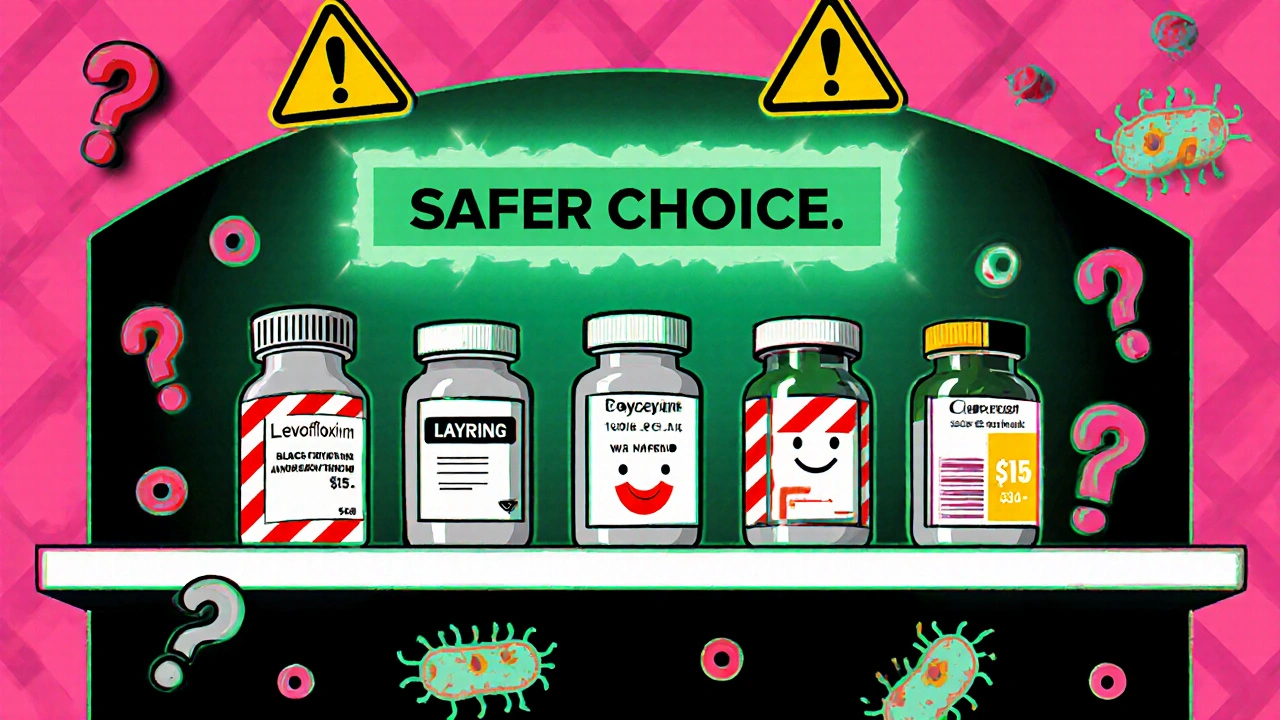When you’re prescribed Lquin (levofloxacin), you might wonder if there’s a better, cheaper, or safer option. It’s not just about picking any antibiotic - it’s about matching the right drug to your infection, your body, and your history. Levofloxacin is a strong fluoroquinolone antibiotic, used for pneumonia, urinary tract infections, sinus infections, and sometimes skin or prostate infections. But it’s not the only player in the game. Many doctors now turn to other antibiotics first - and for good reason.
How Levofloxacin Works and When It’s Used
Levofloxacin is a broad-spectrum fluoroquinolone antibiotic that kills bacteria by blocking their ability to reproduce DNA. It was approved in the late 1990s and quickly became popular because it works against both Gram-positive and Gram-negative bacteria. That means it covers a wide range of infections - from E. coli in UTIs to Streptococcus pneumoniae in pneumonia.
Doctors often reach for levofloxacin when:
- A patient has a complicated urinary tract infection (cUTI) that didn’t respond to first-line drugs like nitrofurantoin or trimethoprim
- There’s a suspected resistant strain of bacteria, especially in hospital settings
- The infection is in the lungs (community-acquired pneumonia) and the patient can’t take oral amoxicillin or doxycycline
- The patient is allergic to penicillin or sulfa drugs
But here’s the catch: levofloxacin isn’t harmless. The FDA issued black box warnings in 2008 and again in 2016 about serious side effects - including tendon rupture, nerve damage, and worsening of myasthenia gravis. These aren’t rare. In one 2022 study of over 200,000 patients, those on fluoroquinolones had a 2.4 times higher risk of aortic aneurysm within 60 days than those on other antibiotics. That’s not something you ignore.
Alternative Antibiotics: What Doctors Choose Instead
Many clinicians now avoid levofloxacin unless absolutely necessary. Here are the most common alternatives - and when each makes sense.
1. Amoxicillin-Clavulanate (Augmentin)
Amoxicillin-clavulanate is a penicillin-based antibiotic combined with a beta-lactamase inhibitor to fight resistant bacteria. It’s the go-to for sinus infections, ear infections, and mild to moderate pneumonia in healthy adults. It’s taken orally, usually twice a day, and has been around since the 1980s. Side effects? Mostly stomach upset and diarrhea. It’s cheaper than levofloxacin and doesn’t carry the same neurological or tendon risks.
It’s not perfect - if you’re allergic to penicillin, you can’t use it. But for most people, it’s a safer first step.
2. Doxycycline
Doxycycline is a tetracycline antibiotic that works well against many respiratory and skin infections, including some caused by atypical bacteria like Mycoplasma. It’s often used for bronchitis, acne, Lyme disease, and even some urinary infections. It’s taken once or twice daily and is much gentler on the body than fluoroquinolones.
One downside: it can cause sun sensitivity. If you’re spending time outdoors in Perth’s summer sun, you’ll need to wear sunscreen. It’s also not recommended for kids under 8 or pregnant women. But for healthy adults, it’s a solid, low-risk option.
3. Cephalexin (Keflex)
Cephalexin is a first-generation cephalosporin used mainly for skin, bone, and soft tissue infections. It’s not as broad as levofloxacin, but it’s excellent for cellulitis or infected cuts. It’s taken four times a day, which is inconvenient, but it’s very well tolerated. People who can’t take penicillin often tolerate cephalexin - about 90% of penicillin-allergic patients can safely use it.
It doesn’t work well for lung infections or complicated UTIs. But for simple infections, it’s a reliable, low-risk choice.
4. Nitrofurantoin
Nitrofurantoin is a urinary-specific antibiotic that concentrates in the bladder and kills common UTI bacteria like E. coli. It’s not absorbed well into the bloodstream, so it doesn’t touch infections outside the urinary tract. But for simple bladder infections, it’s often the first-line choice.
It’s cheaper than levofloxacin and doesn’t carry the same risks. But it’s not for kidney infections - if the infection has spread to the kidneys, you’ll need something stronger. Also, it’s not recommended for people with poor kidney function.
5. Trimethoprim-Sulfamethoxazole (Bactrim)
Trimethoprim-sulfamethoxazole is a combination antibiotic that blocks bacterial folate synthesis, effective against many UTIs and some respiratory infections. It’s been used since the 1970s and is still widely prescribed for uncomplicated UTIs, especially in older adults.
It’s affordable and effective. But it can cause allergic reactions - rashes, fever, or even rare but serious skin conditions like Stevens-Johnson syndrome. It’s also not safe for people with G6PD deficiency or severe liver or kidney disease.
Comparison Table: Levofloxacin vs. Top Alternatives
| Antibiotic | Best For | Dosing Frequency | Common Side Effects | Key Risks | Cost (AUD, 3-day course) |
|---|---|---|---|---|---|
| Levofloxacin (Lquin) | Pneumonia, complicated UTIs, resistant infections | Once daily | Nausea, dizziness, headache | Tendon rupture, nerve damage, aortic aneurysm risk | $45-$65 |
| Amoxicillin-Clavulanate | Sinus, ear, mild pneumonia | Twice daily | Diarrhea, stomach upset | Penicillin allergy reaction | $25-$35 |
| Doxycycline | Bronchitis, Lyme, acne, some UTIs | Once or twice daily | Sun sensitivity, upset stomach | Photosensitivity, esophageal irritation | $20-$30 |
| Cephalexin | Skin, bone, soft tissue infections | Four times daily | Diarrhea, rash | Cephalosporin allergy (rare) | $30-$40 |
| Nitrofurantoin | Simple bladder infections | Twice daily | Nausea, brown urine | Not for kidney infections or poor kidney function | $15-$25 |
| Trimethoprim-Sulfamethoxazole | Uncomplicated UTIs | Twice daily | Rash, nausea, sun sensitivity | Severe allergic reactions, G6PD deficiency risk | $18-$28 |
As you can see, levofloxacin is more expensive and carries higher risks than most alternatives. It’s only the best choice when other drugs have failed or when the infection is severe and likely caused by resistant bacteria.
When Levofloxacin Is Still the Right Choice
That doesn’t mean you should never take it. There are real situations where levofloxacin saves lives.
- You have hospital-acquired pneumonia and other antibiotics failed
- You’re immunocompromised and need broad coverage
- You have a multi-drug resistant UTI confirmed by culture
- You’re allergic to all other classes - penicillin, sulfa, and cephalosporins
In these cases, the risk of not treating the infection outweighs the risk of the drug. But even then, doctors should limit the course to 5-7 days, not the full 10-14 days sometimes prescribed.
What You Should Ask Your Doctor
If you’re prescribed Lquin, don’t just take it. Ask:
- Is this infection confirmed by a culture or test, or is this a guess?
- Have I tried a safer antibiotic first? If not, why not?
- What are the signs of tendon pain or nerve damage I should watch for?
- Can I get a shorter course? Studies show 5-7 days works just as well for many infections.
- Is there a cheaper option covered by my PBS subsidy?
Many patients don’t ask these questions - but they should. Antibiotics aren’t one-size-fits-all. Your body, your history, and your infection type matter more than the brand name on the bottle.

What Happens If You Take Levofloxacin Unnecessarily?
Overusing fluoroquinolones like levofloxacin doesn’t just hurt you - it hurts everyone. Each time you take it when you don’t need it, you increase the chance that bacteria will become resistant. That means the next time you or someone you love gets a serious infection, the drug might not work anymore.
A 2023 report from Australia’s Therapeutic Goods Administration found that resistance to fluoroquinolones in E. coli rose from 12% in 2015 to 28% in 2024. That’s nearly triple in less than a decade. We’re running out of options.
Also, long-term use or repeated courses of levofloxacin can cause permanent nerve damage. Some patients report tingling, burning, or weakness that lasts for months - or never goes away. That’s not a side effect you can shrug off.
Final Takeaway: Safer Is Often Better
Levofloxacin is a powerful tool - but it’s not a first-line tool. For most common infections, older, cheaper, and safer antibiotics work just as well. Amoxicillin-clavulanate, doxycycline, nitrofurantoin, and cephalexin have decades of safe use behind them. They don’t come with black box warnings.
If your doctor prescribes Lquin, don’t assume it’s the best choice. Ask why. Push for alternatives. And if you’re given levofloxacin, know the warning signs: sudden pain in your Achilles tendon, numbness in your hands or feet, or chest pain. Stop the drug and call your doctor immediately.
Antibiotics aren’t candy. They’re precision weapons. Use them wisely - or we’ll all pay the price later.
Is Lquin the same as levofloxacin?
Yes. Lquin is a brand name for the generic drug levofloxacin. They contain the same active ingredient and work the same way. Generic levofloxacin is usually much cheaper and just as effective.
Can I take levofloxacin if I’m allergic to penicillin?
Yes, levofloxacin is safe for people with penicillin allergies because it belongs to a different antibiotic class - fluoroquinolones. But that doesn’t mean it’s always the best choice. Other alternatives like doxycycline or cephalexin (in most cases) are safer and just as effective for many infections.
What are the signs of levofloxacin side effects?
Watch for sudden pain, swelling, or snapping in your tendons - especially the Achilles tendon. Other signs include numbness, tingling, burning in hands or feet, severe dizziness, chest pain, or rapid heartbeat. If you notice any of these, stop taking it and contact your doctor immediately.
How long should I take levofloxacin?
Most infections need only 5-7 days of levofloxacin. Longer courses (10-14 days) increase side effect risks without improving outcomes. Always ask your doctor if a shorter course is appropriate. Never stop early unless advised - but never take it longer than needed.
Are there natural alternatives to levofloxacin?
No. There are no proven natural alternatives that can reliably treat bacterial infections like pneumonia or complicated UTIs. Honey, garlic, or herbal supplements might help with minor symptoms, but they won’t kill the bacteria causing the infection. Relying on them instead of antibiotics can lead to serious complications.
Can levofloxacin cause long-term damage?
Yes. Some people develop permanent nerve damage (peripheral neuropathy), tendon problems, or joint pain after taking levofloxacin. The FDA has documented cases where symptoms lasted years or never resolved. This is why doctors now avoid prescribing it unless absolutely necessary.
Is levofloxacin safe for older adults?
It’s riskier for older adults. They’re more likely to have kidney problems, tendon degeneration, or heart rhythm issues. Fluoroquinolones like levofloxacin can cause low blood sugar, confusion, and aortic rupture in seniors. Doctors should avoid it unless there’s no other option.


